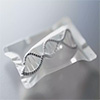| Jul 09, 2025 |
Trans-European research team discovers how a molecular switch controls DNA packing on time for cell division.
|
|
(Nanowerk News) If measured from beginning to end, the DNA in our cells is too long to fit into the cell’s nucleus, explaining why it must be constantly folded and packaged. When it is time for cell division, and the genetic information needs to be passed on to the next generation, DNA must be packed particularly tightly, else serious consequences for a cell’s viability might ensue.
|
|
In a trans-European team effort, researchers from the Max Planck Institute of Molecular Physiology in Dortmund (MPI), the Netherlands Cancer Institute, and the Human Technopole in Milan have now discovered a molecular switch that regulates DNA packing into the typical sausage-shaped chromosomes observed during cell division.
|
|
The discovery of this central mechanism for cell division has many potential applications in medicine and biotechnology.
|
 |
| Images of chromosome spreads without (left) and with condensation defects (right). (Image: Max Planck Institute of Molecular Physiology)
|
From spaghetti to sausages
|
|
Our DNA is constantly being packed and unpacked. And there is a good reason for this: depending on its packing state, it performs different functions in the cell nucleus. For most of its life – this is the time between two cell divisions – our chromosomes look like a disordered, tangled pile of spaghetti, which makes it accessible to be read. When a cell needs to make a copy of itself, a process called “cell division”, the chromosomes must be neatly separated, aligned and then distributed to the daughter cells.
|
|
However, this would be impossible with DNA in spaghetti form. That’s why the DNA strands are wrapped as tightly as possible in preparation for cell division: multiple loops and spirals form compact, neatly-disentangled, sausage-shaped chromosomes with their characteristic X shape, approximately 10,000 times shorter than the original DNA strands.
|
Packing chromosomes too early
|
|
‘Whether our genes can be read or distributed without errors depends on whether the DNA condenses at the right moment,’ says Duccio Conti, postdoctoral researcher in Andrea Musacchio’s department at the MPI and co-first author of the study (Molecular Cell, “Condensin II activation by M18BP1”). Packing tightly the DNA at the wrong time can lead to severe consequences for the cell and for the organism – for example, uncontrolled DNA packing is associated with primary microcephaly. However, how DNA condensation is triggered and controlled when cell division begins remained unknown until now.
|
A timely molecular switch
|
|
‘It was only through the intensive collaboration of our three groups that we were able to discover how DNA condensation during the cell cycle is regulated by a unique molecular switch,’ says Alessandro Borsellini, postdoctoral researcher in Alessandro Vannini’s group at Human Technopole and also co-first author of the study.
|
|
The researchers identified the proteins that regulate condensin II – which is known to drive chromosomes packing in cell division – going onto chromosomes. Two proteins compete mutually for binding to condensin II: when MCPH1 (or microcephalin) binds, condensin II cannot go to the DNA, when M18BP1 binds, condensin II can bind to the DNA and make loops.
|
|
During the time between cell divisions, microcephalin binds to condensin II and keeps it inactive, causing the DNA to look like spaghetti instead of sausages. When the cell begins to divide, the key enzyme CDK1 is activated and phosphorylates both microcephalin and M18BP1, causing a switch of binding partners. Condensin II is thus activated and able to pack the spaghetti into sausage-shaped chromosomes.
|
|
‘For the first time, we understand one of the mechanisms that control DNA packing at the beginning of cell division. This not only clarifies a fundamental process of life, but may also contribute to better understanding of errors in the packing process in the future and, ideally, to their prevention,’ summarises Beccy Harris, postdoctoral researcher in Benjamin Rowland’s laboratory at the Netherlands Cancer Institute and co-first author of the study.
|


